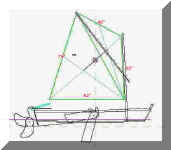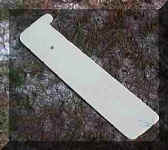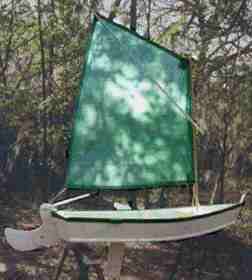 |
Rig Details |
It doesn't take as long as you might think to add
a sail rig to your OSS. I've done the figuring - all you have to
do is MAKE IT!
Links to helpful sites. |
Rudder
Kick up rudder is of 1/2" plywood. The transom mounted part is 16"
tall by 11" wide at base. It tapers to about 6" wide at head. The
tiller is 3/4" thick 23" long, 2" wide tapering to 1" wide
at grip. The 1/2"+ slot to receive the head of rudder is 5"
long. A 1/4" x 21/2" stainless bolt
connects the two, with a self locking cap nut. The rudder blade is
approximately 17" long and 7" wide, and pivots on 3/8"x11/2"
SS bolt - large coffee can lid "washer" acts as bearing between
rudder and kick up blade. If you omit the bird shape you can get more strength
in the rudder head. (What can I say... I was overcome by whimsy.)

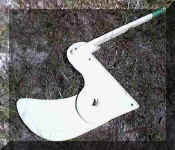
Leading edge of rudder is capped by slit polybutelene tubing.
Rudder head (swans head?) also faced with tubing and rests on top of transom.
Rudder is lashed on in two places - top of transom and at the skeg.
(skeg is 2 feet long 3/4" wide and 3 1/4"
tall.)
Lashing is with releasable cable ties, or 3/16" line.
Dimensions of this 25 sq. ft polytarp sprit sail are 52" on luff (leading edge) , 62" on foot (base), 75" on the leach (trailing edge) and 42" on the head (top edge) It is cut with a 1" outward curve to all side except the trailing edge (leach) which is 2" concave (hollow)
The sail is made with outdoor carpet tape, with a
1/4" bolt rope around the perimeter, with loops protruding from three
corners and two ends at the tack (where base of sail joins mast).
See links below for more detailed instructions. It is made fast to mast with small cable ties, or 1/8" cord ties.
Mast is 6 'x 1 1/4" closet pole, sprit is 6 1/2' x 3/4" square pine
rounded, 5/16" dowel at peak (goes through rope loop at sail peak) and a
5/16" wide x 1" deep notch at base of sprit for snotter.
Snotter is 1/4" cord - constrictor knot (Craig O'Donnel has instructions for tying one of these on his site- see links page) at mast, with an overhand loop "in the bite" - goes around notch in sprit - up through loop and down to 1/2" hole in mast partner. Tensioned like a truckers hitch. Tapering notch cut in 1/2" ply mast partner acts as a jam cleat for snotter. (image later) Experiment with attachment point of snotter to the mast.
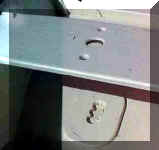 Maststep
& Partner The
mast partner (bench like thwart the mast goes through) is 8" wide
1/2" thick and sits on two cleats mad of 2x2 pine bolted to sides. (could
be glued and screwed but I wanted to be able to adjust it easily) The hole for
the mast is 26" from bow (where stem and upper sides meet at tip) The
mast step is 4"x8"x3/4" and positioned so mast is vertical. (
It could be smaller, but I also added two overlapping holes so the mast
could be raked fore or aft.) In light air a forward raked mast makes the sail
naturally swing forward.
Maststep
& Partner The
mast partner (bench like thwart the mast goes through) is 8" wide
1/2" thick and sits on two cleats mad of 2x2 pine bolted to sides. (could
be glued and screwed but I wanted to be able to adjust it easily) The hole for
the mast is 26" from bow (where stem and upper sides meet at tip) The
mast step is 4"x8"x3/4" and positioned so mast is vertical. (
It could be smaller, but I also added two overlapping holes so the mast
could be raked fore or aft.) In light air a forward raked mast makes the sail
naturally swing forward.
1/4" line around sail perimeter acts as down haul, and goes through another 1/2" hole and another jam cleat notch.
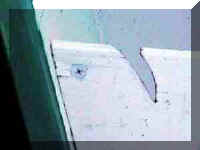 This
is a blow up of the notch cleat seen in upper left corner of previous photo.
This
is a blow up of the notch cleat seen in upper left corner of previous photo.
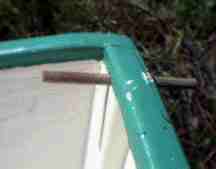
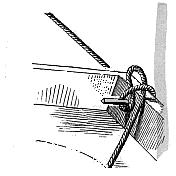
I put 1/2" dowels through the corners of the transom, as cleats to control the main sheet. With this boomless, loose footed sail you need as wide a sheeting angle as this little boat will give.
Leeboard is 1/2" ply 7"x33" (with a 2"x2" ear at the top aft edge for a handle) with 21" wetted" (in the water), pivots on 3/8"x 21/2"SS bolt with fender washers, wing nut, and regular nut to lock them together. The leeboard is attached at the widest part of the boat, 39" from bow. The pivot bolt is 5" down from top of gunwale. The bolt passes through the board, which bears against the gunwale and the chine log, then through an elliptical wooden spacer approx. 3" long, 1 1/2" wide, and 5/8" thick.
 This spacer fills the gap between side and leeboard when board is
touching the gunwale and chine log. The elliptical shape reduces resistance when water passes between board and side.
This spacer fills the gap between side and leeboard when board is
touching the gunwale and chine log. The elliptical shape reduces resistance when water passes between board and side.
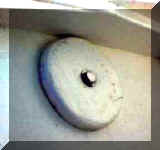 There
is a 4" round 1/2" thick backing plate on the inside of the leeboard
bolt. Mine is on the port side, but it can be on either.
There
is a 4" round 1/2" thick backing plate on the inside of the leeboard
bolt. Mine is on the port side, but it can be on either.
Links to sail making info:
Polysail - they sell kits for making white poly tarp sails - good tutorial too! http://members.aol.com/polysail/Jim Machilak's essays: The archives has much info on sail design and making. He's a great resource for amateur designers. And some nice boat plans as well. Send for his catalog!
http://www.apci.net/~michalak/Craig O'Donnel's Cheap Pages: Lots of polytarp sail making inspiration.
http://www.friend.ly.net/user-homepages/d/dadadata/oddsails.htmlI met Frank on the boatdesign list. He has some great ideas about poly sails: http://sites.netscape.net/frankellinghaus/pages_English/boatbuilding/sailglueing.htm
Robert Laine's amazing sail design software! http://users.bart.nl/~jmlaine/sailcut/
A Tyvek sail - the paper houses are wrapped in and shipping bags are made from. http://www.cyber-dyne.com/~jkohnen/Tyvek/index.html
For more info, or comments contact David at:
simplicityboats
